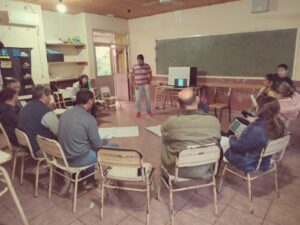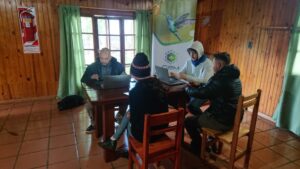Analysis of the area of influence of the Selva Paranaense Vida Nativa GS1 Reserve.
Delimitation of the Area of Influence of SPVN GS1 Reserve
The “SPVN GS1 Reserve” is located in a 25,000 hectare property belonging to Forestal Belga S.A., located in the municipality of San Pedro.
The area of influence of the project includes the project area or site (SPVN GS1 Reserve) and the areas of Gentile, Piñeiro, Alegría, Cruce Caballero, Tobuna and Tekoa Alecrín.
Cruce Caballero and Tobuna are the main rural agglomerations for which it is possible to find official census information. The rest of the places are considered dispersed rural clusters and, therefore, not censusable.

Stakeholder identification and analysis
The stakeholder identification and analysis process consisted, first of all, of a brainstorming with the collaboration of key informants, who were able to provide a local and situated view on the relevant actors that may have an influence and/or be affected by the project. This allowed for a preliminary classification of sectors distinguished by gender, ethnic group, level of wealth or well-being, livelihoods, but also community-based organizations, local government influencers, public organizations and others.
After this preliminary identification, secondly, field research continued with a mixed – or triangulated – multistage design. In general terms, this strategy brought together interviews of maximum variation; under the logics of “key actor”, “snowball” and “focus group” with censuses of rural households in villages, towns and native communities; with a random sample selection by conglomerates for villages and community villages, and with a directed sample selection by conglomerates for community groups.
Mixed strategy implemented:
- Meetings with stakeholders based on a convenience sample.
- Ethnographic approach: participant observation, descriptive and detailed recording of social daily life, open anthropological interview, intercultural dialogue.
- Semi-structured interviews on focal themes (human capital, degree of dependence on the forest, economy, social capital, climate change) through chain or “snowball” sampling.
- Thematic focal interview or focus group for agriculture and indigenous habitat issues and perception of local problems in Cruce Caballero.
- Participatory rural assessment: SWOT matrix for self-diagnosis of community organization.
- Survey of rural households. Three household censuses were conducted:
- The first was a pilot or ex ante test, in the rural areas surrounding the property, based on a non-probabilistic sample of maximum variation with criteria of gender, income difference and place of residence.
- The second household census with a sample of 60% of the households of Tekoa Alecrín (24 households), under a cluster sampling. The type of sampling used in this case is the culturally appropriate methodology achieved through intercultural dialogue with the council of authorities of the community group.
- The third household census will be carried out at the end of October, in Cruce Caballero, Paraje Piñeiro, Colonia Alegría and Tobuna, following a probabilistic sampling procedure, in this case random by clusters.
- Georeferencing and cartographic updating of houses, community infrastructure, stores, community spaces, access points, roads, routes, services, sites of cultural interest and other points of interest for the local population. The methodology combined geolocation, interviews with community members and the use of geographic processing software.



Analytical conclusions:
This mixed strategy methodology made it possible to identify as a community the resident population of the surrounding rural areas that are outside the boundaries of the site or SPVN GS1 Reserve, insofar as they share language and culture, religious beliefs, way of life, type of occupation and income scale, reproduction patterns, access to public education and health systems, etc.
As community groups, women, indigenous peoples, and people with greater economic and social vulnerability were identified, as their income, livelihoods and/or cultural values differ widely from those of other groups.






